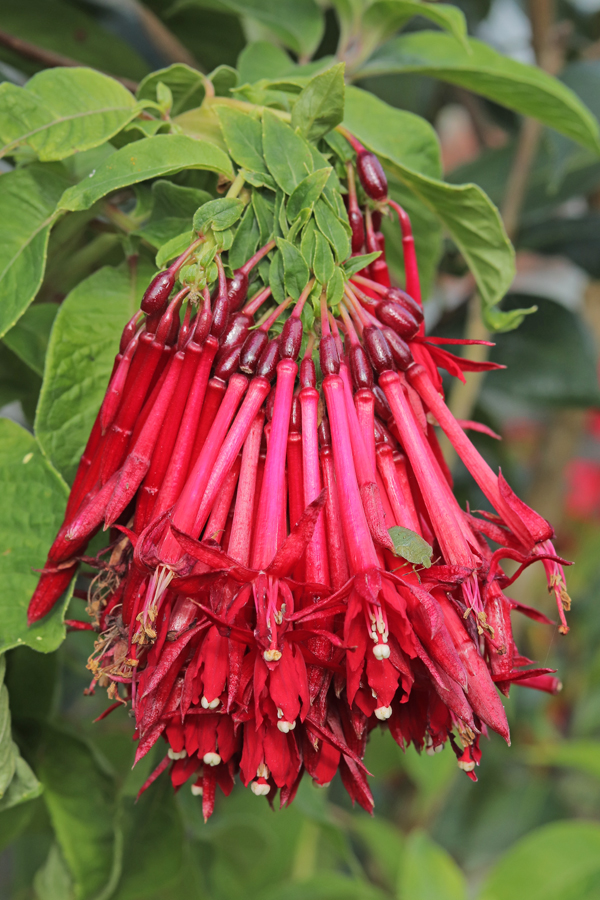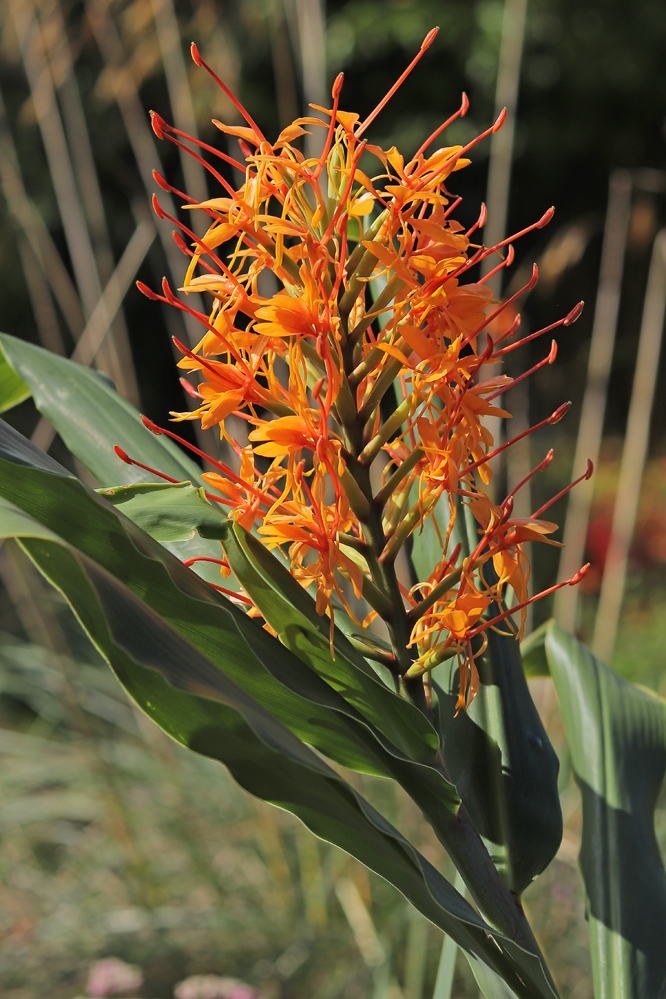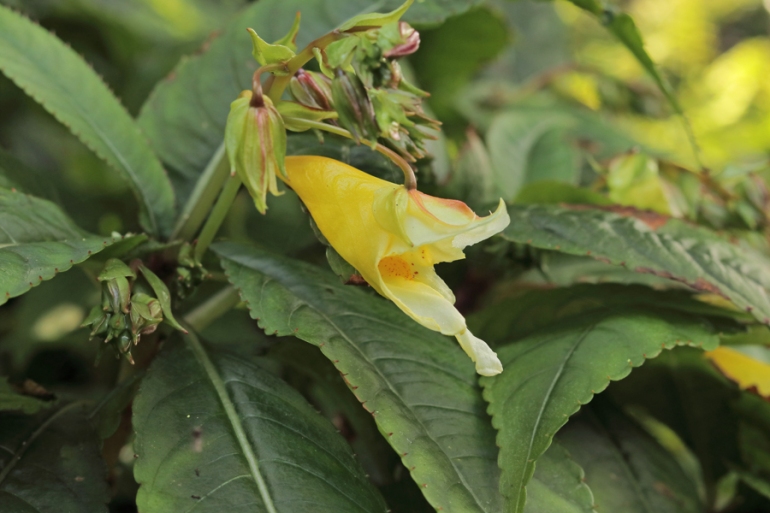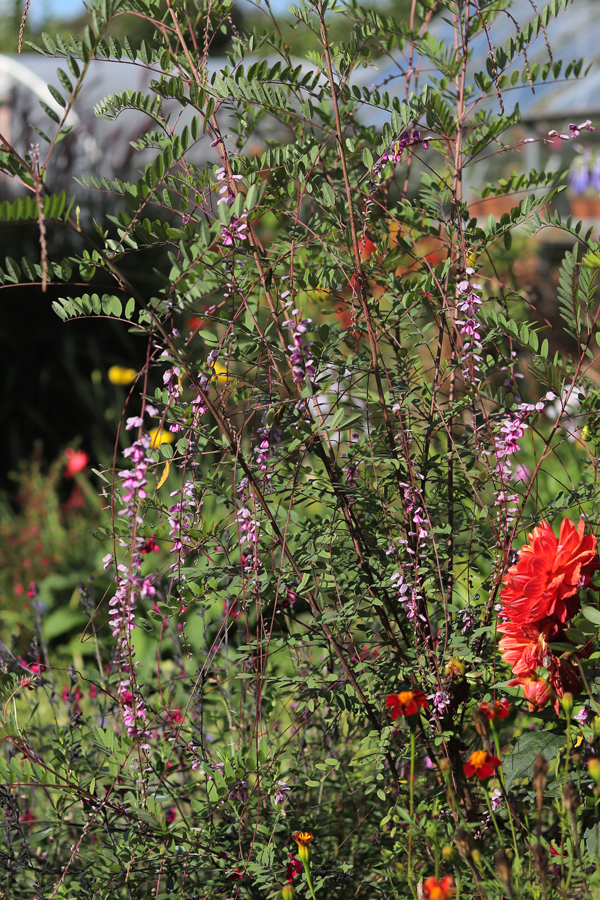It’s one of those beautiful bright mornings where you go out, take a deep breath and go back in for a jumper. I intend to spend time on my allotment; Monty says it’s time to prune my Blackcurrants, not that I watched GW. A bit of weeding wouldn’t go amiss either and I should dead head my dahlias, keep the bees food supply going as long as I can. There’s lots going on here in the garden, no problem finding six yet.
One.
The new glasshouse. Last weeks picture showed the completed frame, which is how far I’d got by Saturday morning. The rest of Saturday saw the whole structure completed and Sunday was spent doing the glazing. Monday was wet but I was able to complete the staging and vent openers in the dry, as well as getting some of the displaced stuff from the ex shed tucked in under the staging. Two years ago I put in a picture of the area at the side of the house, describing it as a failure. It’s still not perfect but it has certainly improved.
Two.
Fuchsia of the week. Fuchsia boliviana. This is a species that we have grown in the garden for many years where it gets killed to the ground by the first frost each year, then grows up again to sometimes flower very late in the year, sometimes not. We took a few cuttings a couple of years back and kept them in the tunnel through last winter, meaning they didn’t die down and have flowers on them now.

Three.
Hedychium ‘Tara’. This was collected from the rim of the Kathmandu Valley as seed in 1972 by Tony Schilling, who was curator of Wakehurst Place. Botanists have still not decided whether it is a form of H. coccineum or a natural hybrid. I thought I’d dug this plant out as it was in the root zone of a big conifer and way too dry in summer when it should have been experiencing monsoon rains. I dug and potted up one bit and evidently missed this bit, doing rather better now that the tree has gone. It is fully hardy in southern England.

Four.
Impatiens omeiana ‘Ice Storm’. So named because its new leaves are silvery in spring. I have three forms of Impatiens omeiana, which just might mean I could get seeds. I have them all close together, I should perhaps be making an effort to cross pollinate them; I don’t know whether any of our pollinating insects will do the job. This is in a pot, I struggle to find places that are moist enough for it in the ground. They really don’t like drying out.

Five.
Indigofera pendula. I bought this about a year ago, planted it this spring and included it in a six in June when it was flowering. It had a short rest from flowering but put on a couple of feet of new growth and it is now flowering again from that. The racemes are much longer than earlier, I measured one at 48cm/19 inches. The colour is lost among Dahlias and Ricinus and I don’t want the shade it was throw when larger in the place where it is, so a move is very much on the cards.

Six.
Solidago ‘Fireworks’ and unknown Japanese anemone. I’m content to call this combination a happy accident. There’s a purple Aster just beginning to open at the left of the picture which would contrast even better with the yellow but the Golden Rod is soon over so it won’t happen. I’m not convinced the Solidago flowers long enough to be worth the space it takes up but bees and flies love it while it lasts.

That’s yer lot. Links to loads of other sixes here. I’m off to bring in my onions.



I am sorry for my tardiness. The greenhouse is impressive by now, and would have been even more impressive a week ago when you posted these six.
Has goldenrod always been popular there, or is it a new trend? It seems to be popular in North American, although it was only recently introduced here. I hope it does not naturalize! Our native species is not so impressive.
LikeLike
For most of my life Solidago was a weed that grew along the railway lines to the south of London. Solidago ‘Fireworks’ is a relatively recent cultivar that is supposed to be more ornamental and non-invasive. Though I’ve only just realised it, the weedy one is probably S. canadensis, which comes from Canada, and S. ‘Fireworks’ is listed as a variety of S. rugosa, which also comes from Canada and America. We seem to have only one native species here, S. virgaurea, a much smaller plant which doesn’t form clumps but grows as a single spike of yellow daisy flowers typically 12-18inches tall. My wildflower book lists two more alien species and says eight other species have been recorded as naturalised. Most species come from North America. Wikipedia has a reasonable entry on it but I fell asleep before I reached the end.
LikeLiked by 1 person
I still have not met the goldenrods. The native species is rare. However, because most people here are from somewhere else, I am aware of the reputation of Eastern species. I am also aware of how all of our worst weeds were imported from somewhere else. That is why I am concerned about the recent popularity of goldenrods, even if they are supposed to be well behaved. (That is what we were supposed to believe about pampas grass.)
LikeLike
I can’t help thinking that in current circumstances being overly concerned with what is native and what is not is going to look pretty silly in all too short a time. The way things are going, a good deal of our native flora will be wiped out by climate change in the next century.
LikeLike
I am not convinced of that. Besides, it would be best for nature to do what it will with the flora like it did during previous ice ages. Ecosystems that were destroyed or displaced did not interfere with ecosystems that were out of their reach. For example, flora of North America mostly stayed confined to the southern part of North America during the last ice age, and then moved back in to the north as ice receded. It did not need to compete with flora from South America or Australia.
LikeLiked by 1 person
The Greenhouse looks sublime Jim. Wish I had room for a full one.
LikeLike
It’s already full, need another.
LikeLiked by 1 person
Another wonderful six! You do grow some unusual and fascinating plants. I love that fuchsia and the side area is very much improved.
LikeLiked by 1 person
Wow! I have fuschia envy. The Fuchsia boliviana is amazing
LikeLiked by 1 person
That’s quite a transformation. I have S. ‘Fireworks’ next to Anemone jap ‘Bressingham Glow’. The anemone is in my Six but I didn’t include the Solidago as the flowers are only just opening.
LikeLike
I have Anemone ‘Bressingham Glow’ elsewhere, I nearly posted a picture of it mixed with Fuchsia ‘Delta’s Sarah’ but the Solidago combo edged it.
LikeLike
A fascinating collection – I like the orange spikes of the Hedychium and the combination of golden rod and Japanese anemone is a very happy accident!
LikeLiked by 1 person
Very smart greenhouse! Is it full yet? That fuchsia is stunning. I gave up my solidago a couple of years ago because, although it is a plant I remember from my youth, it is so invasive here.
LikeLike
Sadly, the glasshouse is pretty much full in what, 4 days. Still, that’s what I got it for. Solidago ‘Fireworks’ is, I believe, sterile; at least it doesn’t produce seedlings, though the clump is getting bigger rather quickly.
LikeLike
I’m glad to see you grow impatiens omeiana … Do you manage this with difficulty? Is it easy to grow from seeds or is it better for me to buy a mature plant? I’ve been looking for it for a long time because this plant is very beautiful and the foliage really attractive: I always hesitate to know if it will resist in my area … Otherwise, this bunch of fuchsia flowers is splendid!
LikeLike
I’ve never seen seed of I. omeiana offered. It’s not self fertile, you need more than one clone to stand a chance of seed setting. As far as I know all the forms currently available are clones. It’s easy enough to grow but needs constant moisture or it wilts and then goes dormant until the next spring. It’s frost tender but if damaged in spring it comes up again from below ground. A frost that penetrated 2 or 3cm below ground would kill it.
LikeLiked by 1 person
2 or 3 cm … hum … it happens often here!( or in pot…)
I will look for a cloned plant and try to grow it with serious winter protection. Thank you Jim.
LikeLike